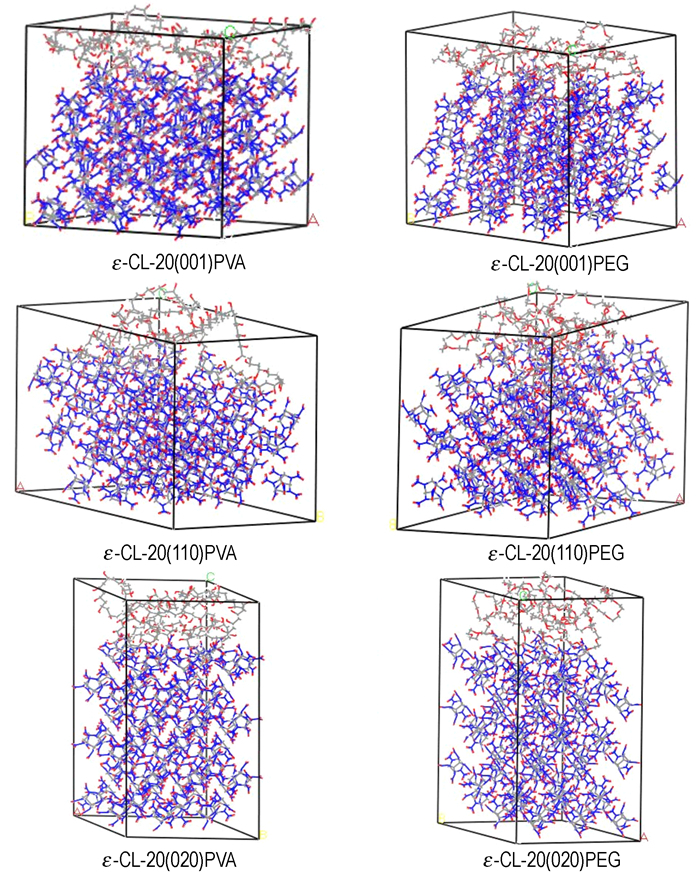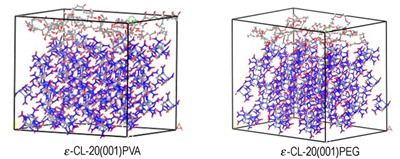2. 中国工程物理研究院冲击波物理与爆轰物理国防科技重点实验室, 四川 绵阳 621999
2. National Key Laboratory of Shock Wave and Detonation Physics, Institute of Fluid Physics, China Academy of Engineering Physics, Mianyang 621999, China
六硝基六氮杂异伍兹烷(HNIW,CL-20)是一种具有笼形结构的新型多环硝胺类高能量密度化合物(HEDC),是迄今为止公认的已获实际应用、威力最大的单质炸药[1]。在已知的4种晶型(α-、β-、γ-和ε-)中,常温常压下以ε-CL-20最为稳定[2],但感度、成本等因素限制了其应用范围。可将ε-CL-20与高分子复合构成复合物,显著改善其安全性能和使用性能。
目前,以包括高聚物黏结炸药(PBX)在内的高能复合材料为研究对象,通过分子动力学(MD)模拟方法,研究高能复合材料的组成、结构与性能的关系,得到越来越多的关注[3-14]。对CL-20晶体,不仅可用MD方法模拟计算其4种晶型的晶胞参数,预测不同温度和压力下CL-20晶体的弹性常数和机械性能[15],还对以ε-CL-20晶体为基的PBX展开了MD模拟研究。如不同晶面对构成PBX的影响[12]、不同PBX种类的相容性、安全性、爆轰性能和力学性能[12, 16],以及ε-CL-20晶体缺陷对PBX结构和性能的影响[17]等,这些研究结果为高能量密度材料ε-CL-20的配方设计提供了理论依据。据文献[18]报导,ε-CL-20晶体的重要晶面有(110)、(001)、(11-1)、(011)、(20-1)和(020),其相应表面积分别占总表面积的47.40%、26.70%、7.13%、2.80%、6.49%和9.38%。
为了进一步探索ε-CL-20晶体与高分子构成复合物对其性能的改善问题,本研究选择聚乙烯醇(PVA)、聚乙二醇(PEG)在占较多表面积的重要晶面(001)、(110)和(020)上,分别构建ε-CL-20/PVA和ε-CL-20/PEG共6种复合物模型,进行常温常压下MD模拟研究,探讨和比较它们的稳定性和力学性能,揭示高聚物PVA和PEG与ε-CL-20之间的界面作用,以为高能量密度材料的理论配方设计提供参考。
2 MD模拟方法和细节 2.1 力场选择和模型搭建MD模拟结果的优劣首先取决于所使用的力场参数,COMPASS力场[19]特别适合硝基含能化合物及其混合体系结构和性能的模拟研究[3, 11, 13, 20]。
构建链段数n=100的高聚物PVA和PEG周期箱,使它们的密度接近实验值(室温ρPVA=1.28 g·mL-1、ρPEG=1.27 g·mL-1)。PVA和PEG分子链链端用H或OH饱和,见图 1,原子数分别为702和703。

|
图 1 PVA与PEG的分子结构 Fig.1 Molecular structures of PVA and PEG |
ε-CL-20晶体的单胞结构取自于X射线衍射测定结果[21],单胞中含有4个ε-CL-20分子。构建ε-CL-20(2×3×3)超晶胞,超晶胞包含有72个ε-CL-20分子,2592个原子。沿ε-CL-20(2×3×3)超晶胞(001)、(110)和(020)晶面切割,设真空层为0,得到晶面切割模型ε-CL-20(001)、ε-CL-20(110)和ε-CL-20(020),分别具有a×b×c=27.39Å×37.66Å×27.08Å、a×b×c=26.50Å×46.57Å×27.74Å和a×b×c=26.50Å×27.39Å×41.69Å,其中c垂直于a×b平面。将前述PVA和PEG周期箱复合其上,获得ε-CL-20(001)/PVA、ε-CL-20(110)/PVA、ε-CL-20(020)/PVA、ε-CL-20(001)/PEG、ε-CL-20(110)/PEG和ε-CL-20(020)/PEG共6个复合物模型,且每个复合物体系均含72个ε-CL-20分子,再加上PVA(PEG)分子共有原子数3294(3295)个,参见图 2。

|
图 2 ε-CL-20/PVA和ε-CL-20/PEG复合物模型 Fig.2 ε-CL-20/PVA and ε-CL-20/PEG composites models |
将已经搭建好的ε-CL-20各晶面切割模型和ε-CL-20/PVA以及ε-CL-20/PEG复合物模型置于COMPASS力场中进行295 K常压下MD模拟研究。选用恒温恒压(NPT)系综、Andersen[22]控温方法和parrinello[23]控压方法,范德华(vdW)作用和静电作用(Coulomb)分别用atom-based和 Ewlad[24]加和方法求得,截断半径取9.5×10-10 m。初始分子运动速度按Maxwell-Boltzmann分布确定; 牛顿运动方程的求解建立在周期性边界条件、时间平均等效于系综平均等基本假设之上,采用改进的Velocity Verlet速度[13]进行求解; 时间步长为1 fs。当温度、势能波动小于10%时,体系达到平衡。模型体系达到平衡后,再运行1 ns,每10 fs收集一次轨迹文件用于统计分析。
3 结果与讨论 3.1 内聚能密度内聚能密度(CED)是单位体积1 mol凝聚体克服分子间作用变为气态时所需能量。在MD模拟中CED是vdW力与静电力之和,即分子间的非键力。表 1中给出了MD模拟求得的纯ε-CL-20晶体、ε-CL-20/PVA和ε-CL-20/PEG复合物的CED及其分量。
| 表 1 ε-CL-20/PVA和ε-CL-20/PEG不同晶面复合物内聚能密度及其分量 Tab.1 Cohesive energy densities and their components for ε-CL-20/PVA and ε-CL-20/PEG composites on different crystalline surfaces kJ·cm-3 |
由表 1可见,比较ε-CL-20/PVA和ε-CL-20/PEG,在相同晶面上,其CED值总是ε-CL-20/PEG>ε-CL-20/PVA; 而对同一复合物,其CED值总是(020)>(001)>(110)。由表 1还可见,晶体ε-CL-20比以其为基的PBX难以气化。整体而言,PEG与ε-CL-20晶体形成的复合物比PVA与ε-CL-20晶体形成的复合物难以由固态变成气态,故ε-CL-20/PEG更稳定。
3.2 结合能定义结合能为相互作用能的负值。在一定温度(295 K)下,本研究复合物的相互作用能等于该温度下复合物平衡结构的总能量减去除掉高分子后该体系的能量,再减去复合物中除掉ε-CL-20后该体系的能量,即:
Ebind=-Einter=-(Etotal-Eε-CL-20-Epoly)
式中, Etotal、Eε-CL-20、Epoly分别表示平衡体系中复合物的总能量,ε-CL-20晶体和PVA或PEG的能量。结合能是度量混合体系中不同组分之间相互作用能大小的重要参数,结合能越大,说明复合体系界面间的相互作用越强,表明形成的复合物的界面结构越稳定。结合能还可用于度量二元体系相容性的优劣[13],结合能越大,则体系相容性越好。
由表 2可见,PVA和PEG在ε-CL-20晶体三个晶面上结合能的大小次序依排均为(001)>(110)>(020)。说明两种高聚物在(001)晶面上的结合能均为最大,其相应复合物的界面结构最稳定。在相同晶面上,ε-CL-20/PEG的结合能总要比ε-CL-20/PVA高,说明前者的界面结构比后者稳定,相容性较好。由此可推断前者的热力学稳定性优于后者。
| 表 2 ε-CL-20/PVA和ε-CL-20/PEG复合物沿不同晶面的结合能及其分量 Tab.2 Binding energies and their components for ε-CL-20/PVA and ε-CL-20/PEG composites on different crystalline surfaces kJ·mol-1 |
CED是体系的整体性质,而结合能是体系中不同物质间的界面性质,后者受体系空间结构的影响更大。
3.3 力学性能力学性能关系到材料的制备、加工和使用。弹性力学性能的基本参量包括弹性系数、工程模量和泊松比。弹性模量是评价材料刚性的指标,是材料抵抗弹性形变能力的度量[25]。塑性和断裂性质与弹性模量是相关联的,体积模量(K)值越大则表明材料断裂强度越大; 剪切模量(G)值越大,材料的硬度和屈服强度越高,二者是材料抵抗塑性形变能力的度量。K与G的比值(K/G)和柯西压(C12-C44),均可用于衡量材料的延展性,K/G值越大材料延展性越好; (C12-C44)值为负,表明材料显脆性,(C12-C44)值若为正,则表明材料延展性较好[26-27]。两者的区别在于前者对材料延展性能的判别是基于关联塑性形变的程度,而后者是基于关联材料断裂面的形貌[28]。表 3列出了基于MD运动轨迹由波动法[29]计算求得的ε-CL-20/PVA和ε-CL-20/PEG复合物的力学性能。
| 表 3 ε-CL-20/PVA和ε-CL-20/PEG不同晶面上复合物的力学性能 Tab.3 Mechanical properties for ε-CL-20/PVA and ε-CL-20/PEG composites on different crystalline surfaces |
复合物ε-CL-20/PVA和ε-CL-20/PEG的力学性能由ε-CL-20晶体,高分子PVA或PEG,以及高分子与晶体所形成界面结构和其间的相互作用所共同决定。由表 3可见,纯ε-CL-20晶体的模量总是比其复合物的大,复合物ε-CL-20/PEG的泊松比(ν)、K/G和柯西压(C12-C44)值总比ε-CL-20/PVA的相应值大。这说明ε-CL-20/PEG的弹性和延展性均优于后者,这是由于PEG主链上有醚键“C—O—C”,其柔顺性超过PVA所致。
4 结论在常温(295 K)常压(1.01×105 Pa)下,对在ε-CL-20不同晶面上构成的ε-CL-20/PVA和ε-CL-20/PEG共6种复合物模型进行了MD比较研究。得到如下主要结论:
(1) 在ε-CL-20相同晶面上,ε-CL-20/PEG比ε-CL-20/PVA的内聚能密度大,说明前者比后者更难以气化,因而更加稳定。
(2) 在ε-CL-20相同晶面上,ε-CL-20/PEG的结合能大于ε-CL-20/PVA,表明前者的相容性优于后者,前者的界面结构较后者稳定; 在ε-CL-20不同晶面上,两种复合物的结合能和稳定性次序均为(001)>(110)>(020)。
(3) 对于相同晶面,纯ε-CL-20晶体的弹性模量均大于复合物ε-CL-20/PEG和ε-CL-20/PVA的模量; 比较这类复合物的力学性能可知,ε-CL-20/PEG在所有晶面上的弹性和延展性均优于ε-CL-20/PVA。这是因为PEG链比PVA链更柔顺的缘故。
总之,本研究的MD模拟结果表明,在构成以ε-CL-20为基的高聚物粘结炸药(PBX)时,PEG是优于PVA的粘结剂。
| [1] |
欧育湘, 孟征, 刘进全. 高能量密度化合物CL-20应用研究进展[J].
化工进展, 2007, 26(12): 1690-1694. OU Yu-xiang, MENG Zheng, LIU Jin-quan. Review of the development of application technologies of CL-20[J]. Chemical Industry and Engineering Progress, 2007, 26(12): 1690-1694. DOI:10.3321/j.issn:1000-6613.2007.12.005 |
| [2] |
欧育湘, 贾会平, 陈博仁, 等. 六硝基六氮杂异伍兹烷四种晶型的晶体结构[J].
火炸药学报, 1998(4): 41-43. OU Yu-xiang, JIA Hui-ping, CHEN Bo-ren el. Crystal structure of four polymorphs of hexanitrohexaazaisowurtzitane[J]. Chinese Journal of Explosives and Propllants, 1998(4): 41-43. |
| [3] |
肖继军, 方国勇, 姬广富, 等. HMX基高聚物粘结炸药(PBX)结合能和力学性能的模拟研究[J].
科学通报, 2004, 49(24): 2520-2524. XIAO Ji-jun, FANG Guo-yong, JI Guang-fu, et al. Simulation investigations in the binding energy and mechanical properties of HMX-based polymer-bonded explosives[J]. Chinese Science Bulletin, 2004, 49(24): 2520-2524. DOI:10.3321/j.issn:0023-074X.2004.24.004 |
| [4] |
肖继军, 马秀芳, 黄玉成, 等. TATB/氟聚物PBX力学性能的分子动力学模拟[J].
含能材料, 2004(增刊): 488-492. XIAO Ji-jun, MA Xiu-fang, HUANG Yu-cheng, et al. Molecular dynamic simulation of mechanical properties of TATB/Fluorine-polymers PBX[J]. Chinese Journal of Energetic Materials(Hanneng Cailiao), 2004(Suppl): 488-492. |
| [5] |
LONG Yao, LIU Yong-gang, NIE Fu-de, et al. The force-field derivation and atomistic simulation of HMX-fluoropolymer mixture explosives[J].
Colloid and Polymer Science, 2012, 290(18): 1855-1866. DOI:10.1007/s00396-012-2705-z |
| [6] |
LONG Yao, LIU Yong-gang, NIE Fu-de, et al. Theoretical study of impacting and desensitizing for HMX-graphite mixture explosive[J].
Shock Waves, 2012, 22(6): 605-614. DOI:10.1007/s00193-012-0394-7 |
| [7] |
LONG Yao, LIU Yong-gang, NIE Fu-de, et al. Force-field derivation and atomistic simulation of HMX-TATB-graphite mixture explosives[J].
Modelling and Simulation in Materials Science and Engineering, 2012, 20(6): 65010-65028. DOI:10.1088/0965-0393/20/6/065010 |
| [8] |
LONG Yao, LIU Yong-gang, NIE Fu-de, et al. Theoretical study of breaking and slipping processes for HMX/graphite interface[J].
Applied Surface Science, 2012, 258(7): 2384-2392. DOI:10.1016/j.apsusc.2011.10.052 |
| [9] |
XIAO Ji-jun, XIAO He-ming, LI Jin-shan, et al. Computation of interface interactions and mechanical properties of HMX-based PBX with estane 5703 from atomatic simulation[J].
Journal of Materials Science, 2008, 43: 5685-5691. DOI:10.1007/s10853-008-2704-0 |
| [10] |
XIAO Ji-jun, ZHU Wei, CHEN Juan, et al. Molecular dynamics study on the relationships of modeling, structural and energy properties with sensitivity for RDX-based PBXs[J].
Science China Chemistry, 2012, 55(12): 2587-2594. DOI:10.1007/s11426-012-4797-1 |
| [11] |
XU Xiao-juan, XIAO He-ming, XIAO Ji-jun, et al. Molecular dynamics simulations for pure ε-CL-20 and ε-CL-20-based PBXs[J].
The Journal of Physical Chemistry B, 2006, 110(14): 7203-7207. DOI:10.1021/jp060077v |
| [12] |
XU Xiao-juan, XIAO He-ming, XIAO Ji-jun, et al. Molecular dynamics simulations on the structures and properties of ε-CL-20-based PBXs-primary theoretical studies on HEDM formulation design[J].
Sci Chin Ser B: Chem, 2007, 50(6): 737-745. DOI:10.1007/s11426-007-0141-6 |
| [13] |
肖继军, 朱卫华, 朱伟, 等.
高能材料分子动力学[M]. 北京: 科学出版社, 2013.
XIAO Ji-jun, ZHU Wei-hua, ZHU Wei, et al. Molecular Dynamics of Energetic Materials[M]. Beijing: Science Press, 2013. |
| [14] |
LONG Yao, CHEN Jun. A molecular dynamics study of the early-time mechanical heating in shock-loaded octahydro-1, 3, 5, 7-tetranitro-1, 3, 5, 7-tetrazocine-based explosives[J].
Journal of Applied Physics, 2014, 116:033516(198) |
| [15] |
TAN Jia-jin, JI Guang-fu, CHEN Xiang-rong, et al. Structure, equation of state and elasticity of crystalline HNIW by molecular dynamics simulation[J].
Physical B: Condensed Matter, 2011, 406(15): 2925-2930. |
| [16] |
刘强, 肖继军, 陈军, 等. 不同温度下ε-CL-20晶体感度和力学性能的分子动力学模拟计算[J].
火炸药学报, 2014, 37(2): 563-569. LIU Qiang, XIAO Ji-jun, CHEN Jun, et al. Molecular dynamic simulation on sensitivity and mechanical properties of ε-CL-20 crystal at different temperatures[J]. Chinese Journal of Explosives and Propllants, 2014, 37(2): 563-569. |
| [17] |
XU Xiao-juan, XIAO Ji-jun, XIAO He-ming, et al. Molecular dynamic simulations on the structures and properties of ε-CL-20(001)/F2314 PBX[J].
Journal of Hazardous Materials, 2010, 175(1): 423-428. |
| [18] |
陈华雄, 陈树森, 金韶华, 等. 六硝基六氮杂异伍兹烷转晶中的分子动力学模拟[J].
火炸药学报, 2007, 30(5): 1-4. CHEN Hua-xiong, CHEN Shu-sen, JIN Shao-hua, et al. Molecular dynamic simulation of the crystallization of HNIW[J]. Chinese Journal of Explosives and Propllants, 2007, 30(5): 1-4. |
| [19] |
SUN H. COMPASS: an ab initio force-field optimized for condensed-phase applications-Overview with details on alkane and benzene compounds[J].
J Phys Chem B, 1998, 102: 7338-7364. DOI:10.1021/jp980939v |
| [20] |
QIU Ling, XIAO He-ming, ZHU Wei-hua, et al. Ab initio and molecular dynamics studies of crystalline TNAD[J].
J Phys Chem B, 2006, 110: 10651-10661. |
| [21] |
赵信歧, 施倪承. ε-六硝基六氮杂异伍兹烷的晶体结构[J].
科学通报, 1995, 40: 2158-2160. ZHAO Xin-qi, SHI Ni-cheng. Crystal sturcture of ε-hexanitrohexaazaisowurtzitane[J]. Chinese Science Bulletin, 1995, 40: 2158-2160. DOI:10.3321/j.issn:0023-074X.1995.23.013 |
| [22] |
Andersen H C. Molecular dynamics simulations at constant pressure and/or temperature[J].
J Chem Phys, 1980, 72(4): 2384-2393. DOI:10.1063/1.439486 |
| [23] |
Parrinello M, Rahman A. Polymorphic transitions in single crystals: a new molecular dynamics method[J].
J Appl Phys, 1981, 52(12): 7182-7190. DOI:10.1063/1.328693 |
| [24] |
Allen M P, Tildesley D J.
Computer simulation of liquids[M]. Oxford: Oxford University Press, 1987: 156.
|
| [25] |
Weiner J H.
Statistical mechanics of elasticity[M]. John Wiley, New York: 1983.
|
| [26] |
Pugh S F. Relations between the elastic moduli and the plastic properties of polycrystalline pure metals[J].
Philosophical Magazine, 1954, 45(367): 823-843. |
| [27] |
Pettifor D G. Theoretical predictions of structure and related properties of intermetallics[J].
Materials Science and Technology, 1992, 8(4): 345-349. DOI:10.1179/mst.1992.8.4.345 |
| [28] |
XIAO Ji-jun, WANG Wen-wei, CHEN Jun, et al. Study on structure, sensitivity and mechanical properties of HNX-based PBXs with molecular dynamics simulation[J].
Computational and Theoretical Chemistry, 2012, 999: 21-27. DOI:10.1016/j.comptc.2012.08.006 |
| [29] |
Parrinello M, Rahman A. Strain fluctuation and elastic constants[J].
J Chem Phys, 1982, 76: 2662-2666. DOI:10.1063/1.443248 |

The stability and mechanical properties of ε-CL-20(001)/PVA and ε-CL-20(001)/PEG composites were comparatively studied by molecular dynamics(MD) simulations.




